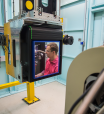
Showing 21 - 40 of 231 results
Deciphering the complex molecular activity that leads to cell death
Research on the mechanism of cell death has insights to bring progress on neurodegenerative diseases and plant biosecurity.
Celebrating Australian women in nuclear
Highlighting the contribution of four inspirational ANSTO leaders on International Women's Day.

Call for Proposals
Proposals at the Australian Centre for Neutron Scattering and National Deuteration Facility.
Synchrotron leader shines bright, becoming a Fellow of ATSE
The Australian Academy of Technology and Engineering (ATSE) has elected Professor Andrew Peele, Director of ANSTO’s Australian Synchrotron, to become a Fellow of the prestigious organisation.

Role at ANSTO

Facilities
ANSTO has a full suite of mineralogical, chemical and hydrometallurgical facilities from laboratory through to pilot scale.

Community FAQs
Frequently asked questions about ANSTO for the community.
Advanced Diffraction & Scattering Beamlines (ADS-1 and ADS-2) UNDER CONSTRUCTION
The Advanced Diffraction and Scattering beamlines (ADS-1 and ADS-2) are two independently operating, experimentally flexible beamlines that will use high-energy X-ray diffraction and imaging to characterise the structures of new materials and minerals.

Role at ANSTO
Nuclear power technologies
Nuclear power is used as a reliable and clean energy solution in most OECD countries and many other parts of the world. Although it is banned in Australia, a number of government reviews are looking at current prohibitions on nuclear power.
Joint-funded Postdoctoral Fellow
Top Coder winner announced
Padstow North and Caringbah North selected as winners of ANSTO's Top Coder competition.
Powerful mathematical calculations guide the startup of a nuclear reactor
The nuclear analysis team at ANSTO recently had a significant role in the re-design and optimisation of a cold neutron source facility for the reactor, its installation and the subsequent restart after a six-month shutdown.
Research highlights how to make food different and better by design
International researchers have used nuclear techniques at ANSTO - a centre for food materials science - to develop a methodology that could assist in the design of oleogel systems for food applications.

High Performance Macromolecular Crystallography Beamline (MX3)
The High Performance Macromolecular Crystallography beamline will enable the study of very small (sub-5 micrometre) or weakly diffracting crystals, providing a state-of-the-art high-throughput facility for researchers. MX3 will be able to study the structures of large proteins and protein complexes for virology, drug design and industrial applications via goniometer mounted crystals, in-tray screening, or via serial crystallography methods.

Role at ANSTO
Winners of ANSTO's Neutron and Deuteration Impact Awards show benefit to Australian research priorities
The Australian Centre for Neutron Scattering and National Deuteration Facility have announced the first recipients of the Neutron and Deuteration Impact Awards.
ANSTO's National Science Week events
National Science Week is a time to celebrate science and the important role national science agencies like ANSTO play in delivering outcomes that benefit all Australians.

Australian Centre for Neutron Scattering
The Australian Centre for Neutron Scattering (ACNS) is a major research facility for neutron science that comprises a suite of neutron instruments with a range of techniques for scientific investigations in physics, chemistry, materials science, medicine and environmental science among other fields.